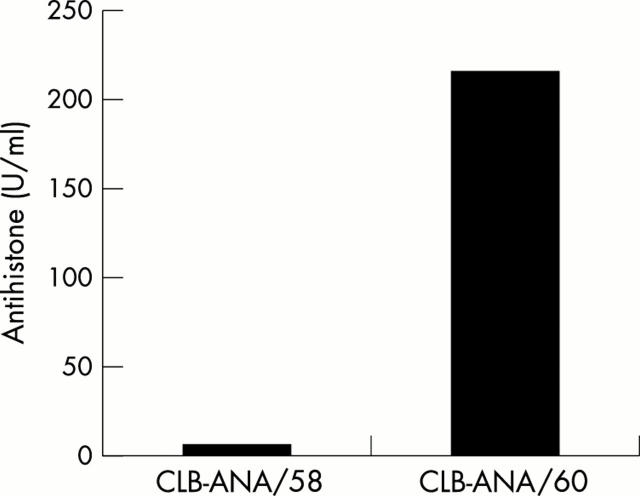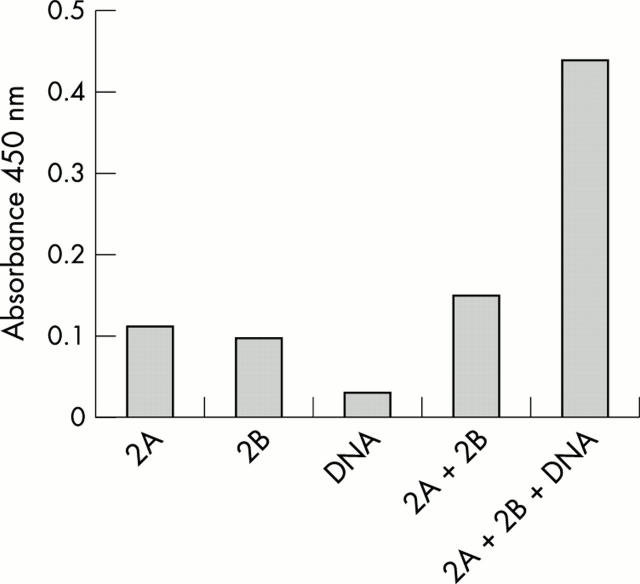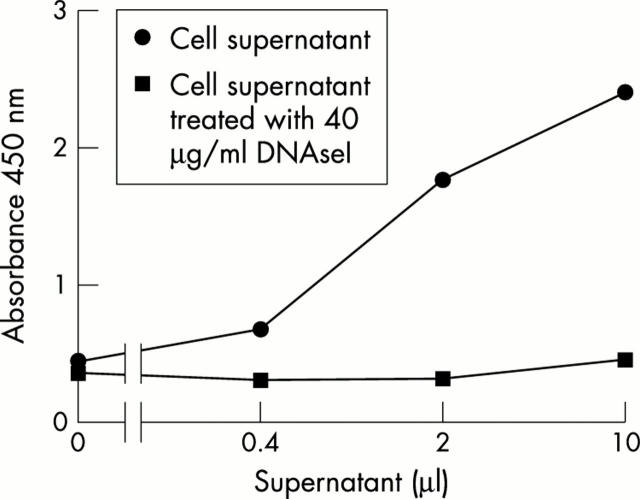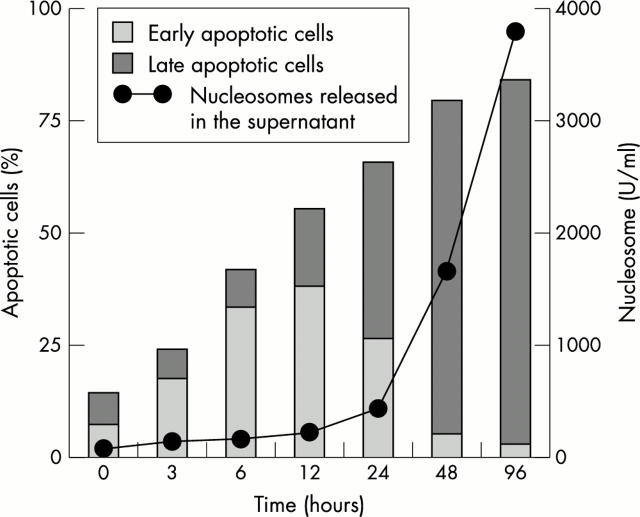Abstract
Objective: To investigate the kinetics of nucleosome leakage from apoptotic cells in an in vitro system and extrapolate the results to autoimmune disease, in particular systemic lupus erythematosus.
Methods: A sensitive nucleosome enzyme linked immunosorbent assay (ELISA) was developed, using a monoclonal antibody (mAb) against histone 3 and an mAb against nucleosomes. Nucleosome release during apoptotic cell death was studied in Jurkat cells. AnnexinV binding (early apoptosis) and propidium iodide positivity (late apoptosis) of the cells were compared with nucleosome release at different times after apoptosis induction.
Results: Nucleosomes appeared in culture supernatant of Jurkat cells 24 to 48 hours after apoptosis induction, when the cells had been late apoptotic for more than 12 hours.
Conclusion: Nucleosomes are released from late apoptotic Jurkat cells, with a 12 hour delay from the appearance of AnnexinV binding cells. This result suggests that in vivo scavenger mechanisms have 12 hours to remove apoptotic material from the circulation.
Full Text
The Full Text of this article is available as a PDF (139.7 KB).
Figure 1 .
Antihistone activity of mAbs CLB-ANA/58 and CLB-ANA/60. The mAbs were tested by ELISA against a mixture of histones H1, H2A, H2B, H3, and H4. Units were calculated by comparison with a standard antihistone mAb, which was defined as 1000 antihistone U/ml.
Figure 2 .
Epitope determination of mAb CLB-ANA/60 on histone immunoblot. (A) 20% SDS-PAA gel with histones, silver staining. (B) Histone immunoblot incubated with 2.5 µg/ml mAb CLB-ANA/60. Lane M, 100 kDa protein marker; lane 1, histone 1; lane 2, histone 2A; lane 3, histone 2B; lane 4, histone 3; lane 5, histone 4.
Figure 3 .
Epitope determination of mAb CLB-ANA/58. Test of mAb on several combinations of histones or DNA, or both.
Figure 4 .
Validation of the nucleosome ELISA using Jurkat cell supernatant incubated 24 hours with 200 µM etoposide. 100% of the cells were late apoptotic.
Figure 5 .
Determination of the time between apoptosis induction and nucleosome release. Apoptosis was induced by addition of 5 µg/ml anti-Fas. Apoptosis was measured by AnnexinV (early apoptosis) and PI (late apoptosis) FACS staining, nucleosomes were measured by ELISA.
Selected References
These references are in PubMed. This may not be the complete list of references from this article.
- Amoura Z., Chabre H., Bach J. F., Jacob L. L'apparition des anticorps anti-nucléosome précède celle des anti-DNA double brin et des anti-histones au cours du lupus murin. Rev Med Interne. 1993;14(10):980–980. doi: 10.1016/s0248-8663(05)80098-0. [DOI] [PubMed] [Google Scholar]
- Amoura Z., Chabre H., Koutouzov S., Lotton C., Cabrespines A., Bach J. F., Jacob L. Nucleosome-restricted antibodies are detected before anti-dsDNA and/or antihistone antibodies in serum of MRL-Mp lpr/lpr and +/+ mice, and are present in kidney eluates of lupus mice with proteinuria. Arthritis Rheum. 1994 Nov;37(11):1684–1688. doi: 10.1002/art.1780371118. [DOI] [PubMed] [Google Scholar]
- Amoura Z., Koutouzov S., Piette J. C. The role of nucleosomes in lupus. Curr Opin Rheumatol. 2000 Sep;12(5):369–373. doi: 10.1097/00002281-200009000-00003. [DOI] [PubMed] [Google Scholar]
- Amoura Z., Piette J. C., Bach J. F., Koutouzov S. The key role of nucleosomes in lupus. Arthritis Rheum. 1999 May;42(5):833–843. doi: 10.1002/1529-0131(199905)42:5<833::AID-ANR1>3.0.CO;2-T. [DOI] [PubMed] [Google Scholar]
- Amoura Z., Piette J. C., Chabre H., Cacoub P., Papo T., Wechsler B., Bach J. F., Koutouzov S. Circulating plasma levels of nucleosomes in patients with systemic lupus erythematosus: correlation with serum antinucleosome antibody titers and absence of clear association with disease activity. Arthritis Rheum. 1997 Dec;40(12):2217–2225. doi: 10.1002/art.1780401217. [DOI] [PubMed] [Google Scholar]
- Arnett F. C., Reveille J. D. Genetics of systemic lupus erythematosus. Rheum Dis Clin North Am. 1992 Nov;18(4):865–892. [PubMed] [Google Scholar]
- Berden J. H., Licht R., van Bruggen M. C., Tax W. J. Role of nucleosomes for induction and glomerular binding of autoantibodies in lupus nephritis. Curr Opin Nephrol Hypertens. 1999 May;8(3):299–306. doi: 10.1097/00041552-199905000-00005. [DOI] [PubMed] [Google Scholar]
- Brard F., Shannon M., Prak E. L., Litwin S., Weigert M. Somatic mutation and light chain rearrangement generate autoimmunity in anti-single-stranded DNA transgenic MRL/lpr mice. J Exp Med. 1999 Sep 6;190(5):691–704. doi: 10.1084/jem.190.5.691. [DOI] [PMC free article] [PubMed] [Google Scholar]
- Brinkman K., Termaat R. M., de Jong J., van den Brink H. G., Berden J. H., Smeenk R. J. Cross-reactive binding patterns of monoclonal antibodies to DNA are often caused by DNA/anti-DNA immune complexes. Res Immunol. 1989 Jun-Aug;140(5-6):595–612. doi: 10.1016/0923-2494(89)90122-3. [DOI] [PubMed] [Google Scholar]
- Brinkman K., Termaat R., Van den Brink H., Berden J., Smeenk R. The specificity of the anti-dsDNA ELISA. A closer look. J Immunol Methods. 1991 May 17;139(1):91–100. doi: 10.1016/0022-1759(91)90355-j. [DOI] [PubMed] [Google Scholar]
- Bruns A., Bläss S., Hausdorf G., Burmester G. R., Hiepe F. Nucleosomes are major T and B cell autoantigens in systemic lupus erythematosus. Arthritis Rheum. 2000 Oct;43(10):2307–2315. doi: 10.1002/1529-0131(200010)43:10<2307::AID-ANR19>3.0.CO;2-J. [DOI] [PubMed] [Google Scholar]
- Casciola-Rosen L. A., Anhalt G., Rosen A. Autoantigens targeted in systemic lupus erythematosus are clustered in two populations of surface structures on apoptotic keratinocytes. J Exp Med. 1994 Apr 1;179(4):1317–1330. doi: 10.1084/jem.179.4.1317. [DOI] [PMC free article] [PubMed] [Google Scholar]
- Casciola-Rosen L., Rosen A. Ultraviolet light-induced keratinocyte apoptosis: a potential mechanism for the induction of skin lesions and autoantibody production in LE. Lupus. 1997;6(2):175–180. doi: 10.1177/096120339700600213. [DOI] [PubMed] [Google Scholar]
- Cohen M. R., Isenberg D. A. Ultraviolet irradiation in systemic lupus erythematosus: friend or foe? Br J Rheumatol. 1996 Oct;35(10):1002–1007. doi: 10.1093/rheumatology/35.10.1002. [DOI] [PubMed] [Google Scholar]
- Du Clos T. W. The interaction of C-reactive protein and serum amyloid P component with nuclear antigens. Mol Biol Rep. 1996;23(3-4):253–260. doi: 10.1007/BF00351177. [DOI] [PubMed] [Google Scholar]
- Golan T. D., Foltyn V., Roueff A. Increased susceptibility to in vitro ultraviolet B radiation in fibroblasts and lymphocytes cultured from systemic lupus erythematosus patients. Clin Immunol Immunopathol. 1991 Feb;58(2):289–304. doi: 10.1016/0090-1229(91)90143-x. [DOI] [PubMed] [Google Scholar]
- Herrmann M., Voll R. E., Zoller O. M., Hagenhofer M., Ponner B. B., Kalden J. R. Impaired phagocytosis of apoptotic cell material by monocyte-derived macrophages from patients with systemic lupus erythematosus. Arthritis Rheum. 1998 Jul;41(7):1241–1250. doi: 10.1002/1529-0131(199807)41:7<1241::AID-ART15>3.0.CO;2-H. [DOI] [PubMed] [Google Scholar]
- Hicks P. S., Saunero-Nava L., Du Clos T. W., Mold C. Serum amyloid P component binds to histones and activates the classical complement pathway. J Immunol. 1992 Dec 1;149(11):3689–3694. [PubMed] [Google Scholar]
- Holdenrieder S., Stieber P., Bodenmüller H., Busch M., Von Pawel J., Schalhorn A., Nagel D., Seidel D. Circulating nucleosomes in serum. Ann N Y Acad Sci. 2001 Sep;945:93–102. doi: 10.1111/j.1749-6632.2001.tb03869.x. [DOI] [PubMed] [Google Scholar]
- Holdenrieder S., Stieber P., Bodenmüller H., Fertig G., Fürst H., Schmeller N., Untch M., Seidel D. Nucleosomes in serum as a marker for cell death. Clin Chem Lab Med. 2001 Jul;39(7):596–605. doi: 10.1515/CCLM.2001.095. [DOI] [PubMed] [Google Scholar]
- Jacob L., Viard J. P. Anti-DNA antibodies and their relationships with anti-histone and anti-nucleosome specificities. Eur J Med. 1992 Nov;1(7):425–431. [PubMed] [Google Scholar]
- Kalden J. R. Defective phagocytosis of apoptotic cells: possible explanation for the induction of autoantibodies in SLE. Lupus. 1997;6(3):326–327. doi: 10.1177/096120339700600326. [DOI] [PubMed] [Google Scholar]
- Korb L. C., Ahearn J. M. C1q binds directly and specifically to surface blebs of apoptotic human keratinocytes: complement deficiency and systemic lupus erythematosus revisited. J Immunol. 1997 May 15;158(10):4525–4528. [PubMed] [Google Scholar]
- Kowal C., Weinstein A., Diamond B. Molecular mimicry between bacterial and self antigen in a patient with systemic lupus erythematosus. Eur J Immunol. 1999 Jun;29(6):1901–1911. doi: 10.1002/(SICI)1521-4141(199906)29:06<1901::AID-IMMU1901>3.0.CO;2-L. [DOI] [PubMed] [Google Scholar]
- Kramers C., Hylkema M. N., van Bruggen M. C., van de Lagemaat R., Dijkman H. B., Assmann K. J., Smeenk R. J., Berden J. H. Anti-nucleosome antibodies complexed to nucleosomal antigens show anti-DNA reactivity and bind to rat glomerular basement membrane in vivo. J Clin Invest. 1994 Aug;94(2):568–577. doi: 10.1172/JCI117371. [DOI] [PMC free article] [PubMed] [Google Scholar]
- Kramers K., Stemmer C., Monestier M., van Bruggen M. C., Rijke-Schilder T. P., Hylkema M. N., Smeenk R. J., Muller S., Berden J. H. Specificity of monoclonal anti-nucleosome auto-antibodies derived from lupus mice. J Autoimmun. 1996 Dec;9(6):723–729. doi: 10.1006/jaut.1996.0094. [DOI] [PubMed] [Google Scholar]
- Maekawa Y., Yasutomo K. Defective clearance of nucleosomes and systemic lupus erythematosus. Trends Immunol. 2001 Dec;22(12):662–663. doi: 10.1016/s1471-4906(01)02084-1. [DOI] [PubMed] [Google Scholar]
- Manfredi A. A., Rovere P., Galati G., Heltai S., Bozzolo E., Soldini L., Davoust J., Balestrieri G., Tincani A., Sabbadini M. G. Apoptotic cell clearance in systemic lupus erythematosus. I. Opsonization by antiphospholipid antibodies. Arthritis Rheum. 1998 Feb;41(2):205–214. doi: 10.1002/1529-0131(199802)41:2<205::AID-ART4>3.0.CO;2-0. [DOI] [PubMed] [Google Scholar]
- Manfredi A. A., Rovere P., Heltai S., Galati G., Nebbia G., Tincani A., Balestrieri G., Sabbadini M. G. Apoptotic cell clearance in systemic lupus erythematosus. II. Role of beta2-glycoprotein I. Arthritis Rheum. 1998 Feb;41(2):215–223. doi: 10.1002/1529-0131(199802)41:2<215::AID-ART5>3.0.CO;2-X. [DOI] [PubMed] [Google Scholar]
- Manheimer-Lory A. J., Zandman-Goddard G., Davidson A., Aranow C., Diamond B. Lupus-specific antibodies reveal an altered pattern of somatic mutation. J Clin Invest. 1997 Nov 15;100(10):2538–2546. doi: 10.1172/JCI119796. [DOI] [PMC free article] [PubMed] [Google Scholar]
- Mevorach D., Mascarenhas J. O., Gershov D., Elkon K. B. Complement-dependent clearance of apoptotic cells by human macrophages. J Exp Med. 1998 Dec 21;188(12):2313–2320. doi: 10.1084/jem.188.12.2313. [DOI] [PMC free article] [PubMed] [Google Scholar]
- Napirei M., Karsunky H., Zevnik B., Stephan H., Mannherz H. G., Möröy T. Features of systemic lupus erythematosus in Dnase1-deficient mice. Nat Genet. 2000 Jun;25(2):177–181. doi: 10.1038/76032. [DOI] [PubMed] [Google Scholar]
- Ogden C. A., deCathelineau A., Hoffmann P. R., Bratton D., Ghebrehiwet B., Fadok V. A., Henson P. M. C1q and mannose binding lectin engagement of cell surface calreticulin and CD91 initiates macropinocytosis and uptake of apoptotic cells. J Exp Med. 2001 Sep 17;194(6):781–795. doi: 10.1084/jem.194.6.781. [DOI] [PMC free article] [PubMed] [Google Scholar]
- Oliveri M., Daga A., Cantoni C., Lunardi C., Millo R., Puccetti A. DNase I mediates internucleosomal DNA degradation in human cells undergoing drug-induced apoptosis. Eur J Immunol. 2001 Mar;31(3):743–751. doi: 10.1002/1521-4141(200103)31:3<743::aid-immu743>3.0.co;2-9. [DOI] [PubMed] [Google Scholar]
- Pablos J. L., Gomez-Reino J. J. Defective phagocytosis in systemic lupus erythematosus. Eur J Clin Invest. 1998 Oct;28(10):864–865. doi: 10.1046/j.1365-2362.1998.00261.x. [DOI] [PubMed] [Google Scholar]
- Perniok A., Wedekind F., Herrmann M., Specker C., Schneider M. High levels of circulating early apoptic peripheral blood mononuclear cells in systemic lupus erythematosus. Lupus. 1998;7(2):113–118. doi: 10.1191/096120398678919804. [DOI] [PubMed] [Google Scholar]
- Platt N., da Silva R. P., Gordon S. Recognizing death: the phagocytosis of apoptotic cells. Trends Cell Biol. 1998 Sep;8(9):365–372. doi: 10.1016/s0962-8924(98)01329-4. [DOI] [PubMed] [Google Scholar]
- Ravirajan C. T., Rowse L., MacGowan J. R., Isenberg D. A. An analysis of clinical disease activity and nephritis-associated serum autoantibody profiles in patients with systemic lupus erythematosus: a cross-sectional study. Rheumatology (Oxford) 2001 Dec;40(12):1405–1412. doi: 10.1093/rheumatology/40.12.1405. [DOI] [PubMed] [Google Scholar]
- Salgame P., Varadhachary A. S., Primiano L. L., Fincke J. E., Muller S., Monestier M. An ELISA for detection of apoptosis. Nucleic Acids Res. 1997 Feb 1;25(3):680–681. doi: 10.1093/nar/25.3.680. [DOI] [PMC free article] [PubMed] [Google Scholar]
- Smeenk R. J., Brinkman K., van den Brink H. G., Westgeest A. A. Reaction patterns of monoclonal antibodies to DNA. J Immunol. 1988 Jun 1;140(11):3786–3792. [PubMed] [Google Scholar]
- Utz P. J., Anderson P. Posttranslational protein modifications, apoptosis, and the bypass of tolerance to autoantigens. Arthritis Rheum. 1998 Jul;41(7):1152–1160. doi: 10.1002/1529-0131(199807)41:7<1152::AID-ART3>3.0.CO;2-L. [DOI] [PubMed] [Google Scholar]
- Utz P. J., Hottelet M., Schur P. H., Anderson P. Proteins phosphorylated during stress-induced apoptosis are common targets for autoantibody production in patients with systemic lupus erythematosus. J Exp Med. 1997 Mar 3;185(5):843–854. doi: 10.1084/jem.185.5.843. [DOI] [PMC free article] [PubMed] [Google Scholar]
- Van Bruggen M. C., Kramers C., Berden J. H. Autoimmunity against nucleosomes and lupus nephritis. Ann Med Interne (Paris) 1996;147(7):485–489. [PubMed] [Google Scholar]
- Welch T. R., Brickman C., Bishof N., Maringhini S., Rutkowski M., Frenzke M., Kantor N. The phenotype of SLE associated with complete deficiency of complement isotype C4A. J Clin Immunol. 1998 Jan;18(1):48–51. doi: 10.1023/a:1023287820786. [DOI] [PubMed] [Google Scholar]
- Williams R. C., Jr, Malone C. C., Meyers C., Decker P., Muller S. Detection of nucleosome particles in serum and plasma from patients with systemic lupus erythematosus using monoclonal antibody 4H7. J Rheumatol. 2001 Jan;28(1):81–94. [PubMed] [Google Scholar]
- Yasutomo K., Horiuchi T., Kagami S., Tsukamoto H., Hashimura C., Urushihara M., Kuroda Y. Mutation of DNASE1 in people with systemic lupus erythematosus. Nat Genet. 2001 Aug;28(4):313–314. doi: 10.1038/91070. [DOI] [PubMed] [Google Scholar]
- van Bruggen M. C., Kramers C., Walgreen B., Elema J. D., Kallenberg C. G., van den Born J., Smeenk R. J., Assmann K. J., Muller S., Monestier M. Nucleosomes and histones are present in glomerular deposits in human lupus nephritis. Nephrol Dial Transplant. 1997 Jan;12(1):57–66. doi: 10.1093/ndt/12.1.57. [DOI] [PubMed] [Google Scholar]







